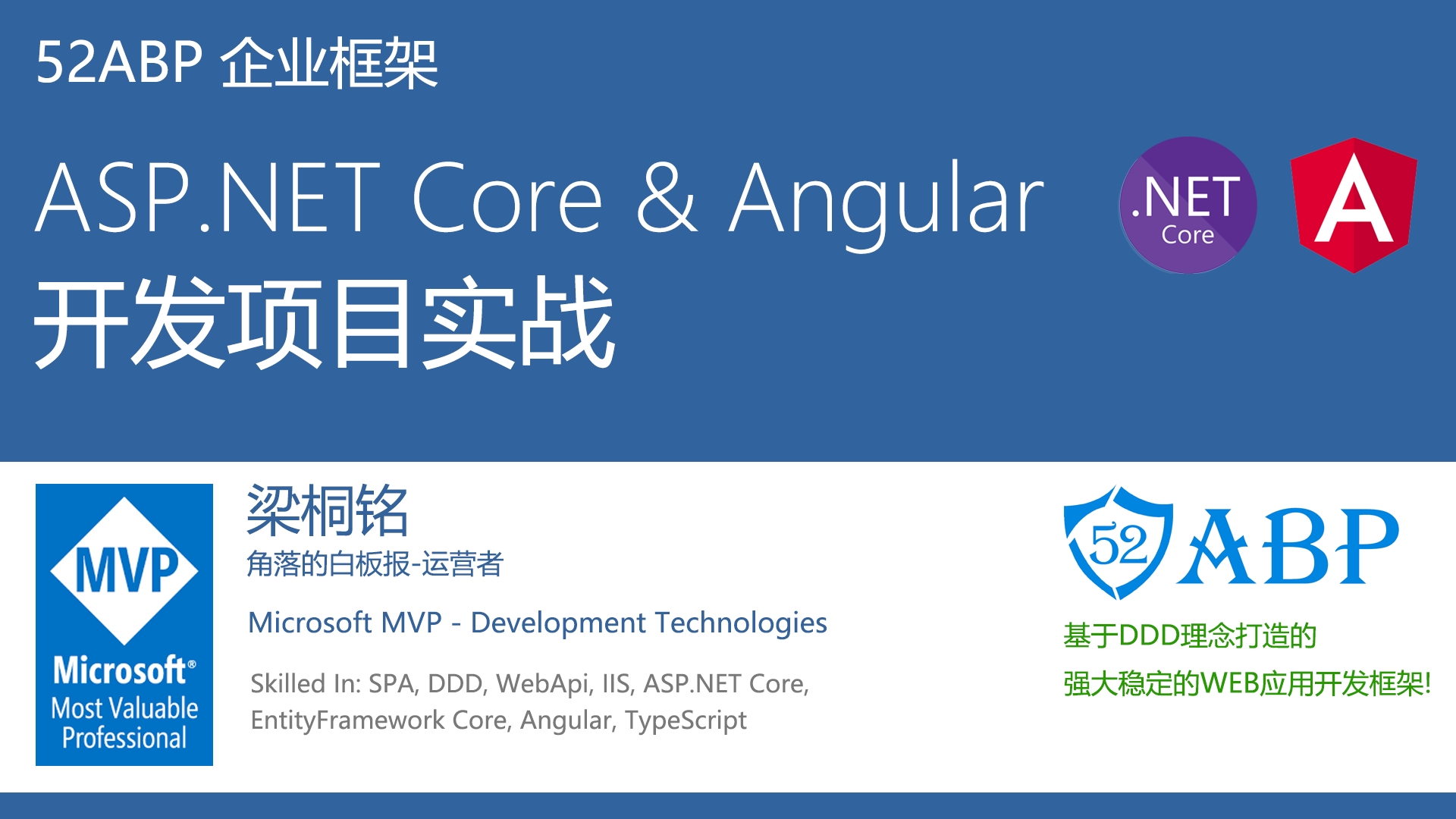ASP.NET Core Appsettings.json 文件
admin
2021-06-03ASP.NET Core 应用程序配置文件介绍
本文作者:梁桐铭- 微软最有价值专家(Microsoft MVP)
本文出自《从零开始学 ASP.NET Core 与 EntityFramework Core》目录
视频课程效果更佳:跨平台开发实战掌握 ASP.NET Core 与 EntityFramework Core
ASP.NET Core appsettings.json 文件
在本章节中,我们将讨论 ASP.NET Core 项目中appsettings.json文件的重要性。
在传统的ASP.NET 版本中中,我们将应用程序配置设置(例如数据库连接字符串)存储在web.config文件中。
在 ASP.NET Core 中, 应用程序配置设置可以来自以下不同的配置源。
- 文件(appsettings.json, appsettings..json)
Environment环境不同,托管在对应环境。 - User secrets (用户机密)
- Environment variables (环境变量)
- Command-line arguments (命令行参数)
appsettings.json文件: 我们的项目是通过 ASP.NET Core 预制的"空"模板创建的,所以我们的项目中已经有一个 appsettings.json 的文件了。
我们可以对文件进行如下修改,补充一个MyKey的键值对:
{
"Logging": {
"LogLevel": {
"Default": "Warning"
}
},
"AllowedHosts": "*",
"MyKey": " appsettings.json中Mykey的值"
}
访问配置信息
若要访问 "Startup " 类中的配置信息, 请注入框架提供的 IConfiguration服务。Startup类位于 startup. cs 文件中。
public class Startup
{
private IConfiguration _configuration;
//注意,我们在这里使用了依赖注入
public Startup(IConfiguration configuration)
{
_configuration = configuration;
}
public void ConfigureServices(IServiceCollection services)
{
}
public void Configure(IApplicationBuilder app, IHostingEnvironment env)
{
if (env.IsDevelopment())
{
app.UseDeveloperExceptionPage();
}
app.Run(async (context) =>
{
await context.Response.WriteAsync(_configuration["MyKey"]);
});
}
}
依赖注入
在以前版本的 ASP.NET 中,依赖注入是可选的,要配置它,我们必须使用像 Ninject,autofac、castle windsor 等第三方框架。
在 ASP.NET Core 中, 依赖注入是不可或缺的一部分。依赖注入能使我们能够创建低耦合、可扩展且易于测试的系统。
我们将在即将推出的视频中详细讨论依赖注入,尽情期待。
ASP.NET Core IConfiguration 服务
IConfiguration服务是为了从 ASP.NET Core 中的所有各种配置源读取配置信息而设计的。- 如果在多个配置源中具有相同密钥名称的配置设置,简单来说就是重名了,则后面的配置源将覆盖先前的配置源 。
- 静态类
WebHost的CreateDefaultBuilder()方法在应用程序启动时会自动去调用,按特定顺序读取配置源。 - 要查看配置源的读取顺序,请查看以下链接上的
ConfigureAppConfiguration()方法 https://github.com/aspnet/MetaPackages/blob/release/2.2/src/Microsoft.AspNetCore/WebHost.cs
检查文件后,您将看到,以下是读取各种配置源的默认顺序
- appsettings.json,
- appsettings..json
- 用户机密
- 环境变量 5.命令行参数
如果您想要改变他们的调用顺序,甚至往里面添加属于自己的自定义配置信息,我们将在后面的课程中讨论如何自定义配置源。
小结
所以翻源代码也没有那么可怕嘛
///<summary>
///Initializes a new instance of the <see cref="WebHostBuilder"/> class with pre-configured defaults using typed Startup.
///</summary>
///<remarks>
///The following defaults are applied to the returned <see cref="WebHostBuilder"/>:
/// use Kestrel as the web server and configure it using the application's configuration providers,
/// set the <see cref="IHostingEnvironment.ContentRootPath"/> to the result of <see cref="Directory.GetCurrentDirectory()"/>,
/// load <see cref="IConfiguration"/> from 'appsettings.json' and 'appsettings.[<see cref="IHostingEnvironment.EnvironmentName"/>].json',
/// load <see cref="IConfiguration"/> from User Secrets when <see cref="IHostingEnvironment.EnvironmentName"/> is 'Development' using the entry assembly,
/// load <see cref="IConfiguration"/> from environment variables,
/// load <see cref="IConfiguration"/> from supplied command line args,
/// configure the <see cref="ILoggerFactory"/> to log to the console and debug output,
/// enable IIS integration.
///</remarks>
///<typeparam name ="TStartup">The type containing the startup methods for the application.</typeparam>
///<param name="args">The command line args.</param>
///<returns>The initialized <see cref="IWebHostBuilder"/>.</returns>
public static IWebHostBuilder CreateDefaultBuilder<TStartup>(string[] args) where TStartup : class =>
CreateDefaultBuilder(args).UseStartup<TStartup>();
文章说明
如果您觉得我的文章质量还不错,欢迎打赏,也可以订阅我的视频哦
未得到授权不得擅自转载本文内容,52abp.com 保留版权
感谢您对我的支持
关注微信公众号:角落的白板报

 52ABP框架ASP.NET Core与Angular开发教程
52ABP框架ASP.NET Core与Angular开发教程






